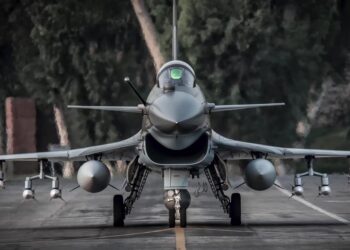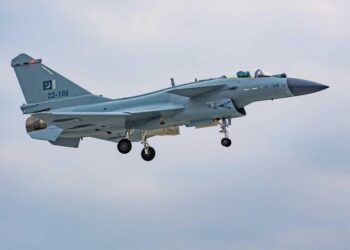NEWTOWN, Conn: After years of unprecedented growth, the pace of overall U.S. defense spending appears to have reached a plateau, and will likely commence a steady decline in the coming years. That is not to say that the Pentagon’s base budget is due for major cuts in the near term, however. Rather, the basis for this anticipated downturn is a shifting security environment overseas, particularly in Iraq.
Indeed, of the total funding obligated for military operations overseas since 2001, over 76 percent was spent in support of Operation Iraqi Freedom (OIF). The U.S. now has an exit strategy in place, and plans to remove its combat forces from Iraq by August 2010, and all remaining personnel by 2011.
According to Forecast International’s latest analysis of the U.S. defense market, “Redeploying U.S. assets in Iraq will be a complex and costly process, and the need to repair or replace equipment damaged or lost in theater will only add to the near-term investment. Nevertheless, the report adds that as combat operations wind down and troops leave Iraq by the thousands, the overall financial burden on the U.S. will slowly begin to ease.
This trend stands in contrast to deteriorating conditions in Afghanistan of late. “That conflict will require additional resources as the U.S. attempts to swing the tide of battle in its favor, and an uncertain timeframe makes long-term costs difficult to estimate,” says Shaun McDougall, Forecast International’s North America Military Markets Analyst and author of the report. On the other hand, less than 20 percent of all U.S. war funding has been dedicated to operations in Afghanistan thus far. Additionally, given its smaller contingent of U.S. soldiers, the yearly cost of operations there is not expected to match that of OIF, which required upwards of 160,000 U.S. troops at its peak.
With regard to the Pentagon’s regular budget, the years of expansive growth have come to an end. Defense Secretary Robert Gates has identified a need for at least 2 percent real growth in the defense budget, in contrast to the administration’s initial plans for spending to remain essentially flat.
“The pressure on DoD topline spending is only exacerbated by an economic downturn,” according to McDougall, “though the Pentagon has at least been spared the massive spending cuts that some countries have been forced to enact.” The U.S. is facing a mounting debt, however, and the long-term threat of entitlement programs remains as ominous as ever.
In the midst of these challenges, the DoD plans to capitalize on the findings of the pending Quadrennial Defense Review to reshape its modernization efforts over the coming years. In many respects, the QDR is likely to back the strategic direction behind many of the program changes that have taken place through 2009, from tactical and strategic aircraft production to shipbuilding and missile defense. A large number of questions remain unanswered, however. “This is because many of the program terminations that were announced by Secretary Gates in April 2009 were simply the result of priorities being deferred or rewritten, rather than eliminated completely,” says McDougall.
The need for a new presidential helicopter, enhanced search-and-rescue capabilities, and a follow-on to today’s long-range bomber fleet, for example, has not vanished. Uncertainties regarding technology development, cost growth, and service requirements have simply put programs such as these on a holding pattern until the Pentagon feels comfortable moving forward once again. Other programs, such as the Marine Corps’ Expeditionary Fighting Vehicle (EFV), will depend on fundamental strategic decisions within the QDR, including the Pentagon’s approach to seabasing and amphibious warfare.
Another goal of the QDR will be to reassess today’s threat environment in an effort to afford the Pentagon a more realistic view of the types of conflicts for which it should prepare. A greater emphasis is expected to be placed on unconventional conflicts, insurgent warfare, and stability operations, while still maintaining conventional superiority. “At the same time, the U.S. could very well be confronted with more than two major conflicts simultaneously, which raises serious questions about the current size of the military and its impact on increasingly tight budgets,” McDougall warns.
Rather than separate the requirements for conventional and unconventional war, Gates has pushed for greater flexibility within the military, in terms of both the types of weapons being bought and the ability of solders to adapt to new threats. Establishing a full-spectrum force capable of defeating a wide range of threats may appear to be the obvious solution, but finding an adequate balance of cost, capability, and quantity in the acquisition system is easier said than done.
“Complicating the entire matter is an acquisition system that is often plagued by severe cost growth and schedule delays,” says McDougall. The administration has taken steps to alleviate some of these problems, including the passage of the Weapons Acquisition Reform Act earlier this year, but the acquisition process still contains many of the same loopholes that the DoD has taken advantage of in the past. And while the acquisition system as a whole is not broken, the fact that many of the Pentagon’s most important – and costly – programs continue to face the same challenges year after year only strengthens the impetus for change.
Forecast International, Inc. is a leading provider of Market Intelligence and Analysis in the areas of aerospace, defense, power systems and military electronics. Based in Newtown, Conn., USA, Forecast International specializes in long-range industry forecasts and market assessments used by strategic planners, marketing professionals, military organizations, and governments worldwide.









